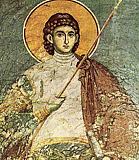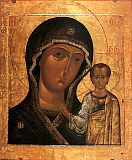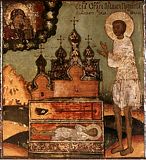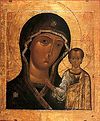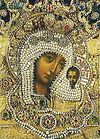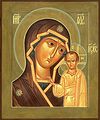

| Previous day | Next day |
| Old Style
July 8
|
Sunday |
New Style
July 21
|
| 5th Sunday after Pentecost. Tone 4. | No fast.
|
![]() Appearance of the Kazan Icon of the Most Holy Theotokos (1579).
Appearance of the Kazan Icon of the Most Holy Theotokos (1579). ![]() Great-martyr Procopius of Caesarea in Palestine, and with him Martyrs Theodosia (his mother), tribunes Antiochus and Nicostratus, and twelve women of senatorial rank (303).
Great-martyr Procopius of Caesarea in Palestine, and with him Martyrs Theodosia (his mother), tribunes Antiochus and Nicostratus, and twelve women of senatorial rank (303). ![]() St. Procopius, fool-for-Christ, wonderworker of Ustiug (Vologda) (1303).
St. Procopius, fool-for-Christ, wonderworker of Ustiug (Vologda) (1303).
Righteous Procopius, fool-for-Christ, of Ustya (Vologda) (ca. 1600).
Icons of the Most Holy Theotokos: weeping “Umileniye” (“Of Tender Feeling”) of Novgorod, and “Peschanskaya.” (1754)
Hieromartyr Epictetus, priest, and Monk-martyr Astion, at Halmyris in Scythia Minor (Romania) (290). Martyr Mirdat, King of Kartli, Georgia (410). Blessed King Edgar the Peaceable, of England (975). Martyrs Virgin Sunniva and companions, on Selje Island (Norway) (10th c.). St. Theophilus the Myrrh-gusher, of Pantocrator Monastery, Mt. Athos (1548). New Hieromartyr Anastasius, priest, of Constantinople (1743). Translation of the relics of St. Demetrius of Basarabov, Bulgaria, to Bucharest (1774).
Slaying of Anastasia Strogilos on the Mount of Olives (1995).
Thoughts for Each Day of the Year
According to the Daily Church Readings from the Word of God
By St. Theophan the Recluse

Fifth Sunday after Pentacost. [Rom. 10:1-10; Matt. 8:28-9:1]
The Gadarenes saw the Lord’s wondrous miracle, when He cast out a legion of devils, and yet, the whole city came out and besought the Lord that He would depart out of their coasts. We do not observe them relating hostilely to the Lord, but neither to we observe any faith in them. They are seized with a sort of indeterminate fearfulness, making them to desire only that the Lord pass them by, wherever He wishes, “only do not touch us.” This is a true image of people who live in peace with their possessions. An order of things has formed around them which is not unfavourable; they are used to it, they have neither thoughts nor the need to change or reverse anything, and they fear to make a new step. They feel, however, that should a command come down from above, the fear of God and their conscience would force them to renounce the old and accept something new. Therefore, they strive to avoid any circumstance which might lead them to such convictions, that they might continue living quietly in their old habits, pleading ignorance. These are the sort of people who are afraid to read the Gospels and patristic books, or to discuss spiritual matters. They fear that if their conscience be thereby disturbed, it might wake up and start forcing them to abandon what they had, and take up something else.
Articles
 Greatmartyr Procopius of Caesarea, in PalestineThe Holy Great Martyr Procopius, in the world Neanius, a native of Jerusalem, lived and suffered during the reign of the emperor Diocletian (284-305). |
